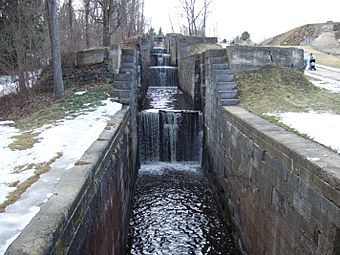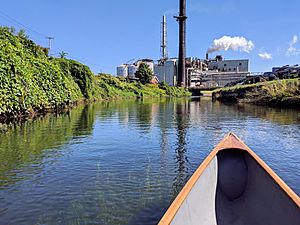Glens Falls Feeder Canal facts for kids
Quick facts for kids |
|
|
Glens Falls Feeder Canal
|
|

"The Combine" : a series of five locks on the Feeder Canal in Fort Edward, New York
|
|
| Location | Warren / Washington counties, New York, USA |
|---|---|
| Built | 1822 |
| NRHP reference No. | 85003401 |
| Added to NRHP | October 25, 1985 |
The Glens Falls Feeder Canal is a special waterway in New York State, USA. It stretches about seven miles (11 km) from Glens Falls through Hudson Falls to Fort Edward. This canal helps move water from the Hudson River to the highest part of the Champlain Canal. You can also explore the Feeder Canal Heritage Trail, which runs alongside a big part of the canal.
Contents
Why Was the Feeder Canal Built?
Early Attempts to Build the Canal
The very first Feeder Canal was built around 1822. It was located near Fort Edward Hill. Its job was to take water from the Hudson River and send it about one-half mile (0.80 km) east to the Champlain Canal.
However, this first canal didn't work well. A big flood damaged the dam across the Hudson River at Fort Edward. This meant the feeder canal couldn't get enough water to do its job.
Building a Better Canal
In 1824, engineers decided to build a new dam. This dam was placed across the Hudson River, further upstream from Glens Falls. After the new dam was ready, work began on digging the Glens Falls Feeder Canal.
This new canal was much longer, about seven miles (11 km) in length. It ran eastward to connect with the Champlain Canal. This new design made sure the Champlain Canal always had enough water, even at its highest points.
Widening the Canal for Boats
By 1832, the Feeder Canal was made even wider and deeper. This change allowed boats to travel on it! To help boats move along the canal, thirteen special structures called locks were built. These locks helped boats go up or down a total of 130-foot (40 m) in height, especially east of Sandy Hill (which is now called Hudson Falls).
One amazing part of this engineering project is the "Five Combines" Locks. These are located in Hudson Falls. The Combine Locks lower the water level by 17 m. Each lock is 15 feet (4.6 m) wide and 100 feet (30 m) long. These sizes actually decided how big canal boats could be in the whole Champlain Canal system! In the early 1900s, a new, larger Champlain Barge Canal was built. This meant boats no longer needed to use the Feeder Canal.
What Is the Feeder Canal Used For Today?
Even though boats don't use it anymore, the canal is still very important. It continues to provide water for the Champlain Canal. It also supplies water to the Finch Pruyn & Company Paper Mill, which is located near the start of the canal in Glens Falls. The New York State Canal Corporation takes care of the canal today.
The canal is also a popular spot for fun activities! Many people enjoy canoeing and kayaking on its calm waters. There's also a seven-mile (11 km) long park and trail along the old towpath. This trail is a favorite place for tourists, joggers, and people who love to cycle.
The Glens Falls Feeder Canal was recognized as a historic place in 1985. It was added to the National Register of Historic Places. A group called the Feeder Canal Alliance was started in 1987. Their goal is to protect, promote, and maintain this important piece of history.
- Historic American Engineering Record (HAER) No. NY-200, "Glens Falls Feeder, Sluice, Along south side of Glens Falls Feeder between locks 10 & 20, Hudson Falls, Washington County, NY", 26 photos, 23 data pages, 3 photo caption pages




